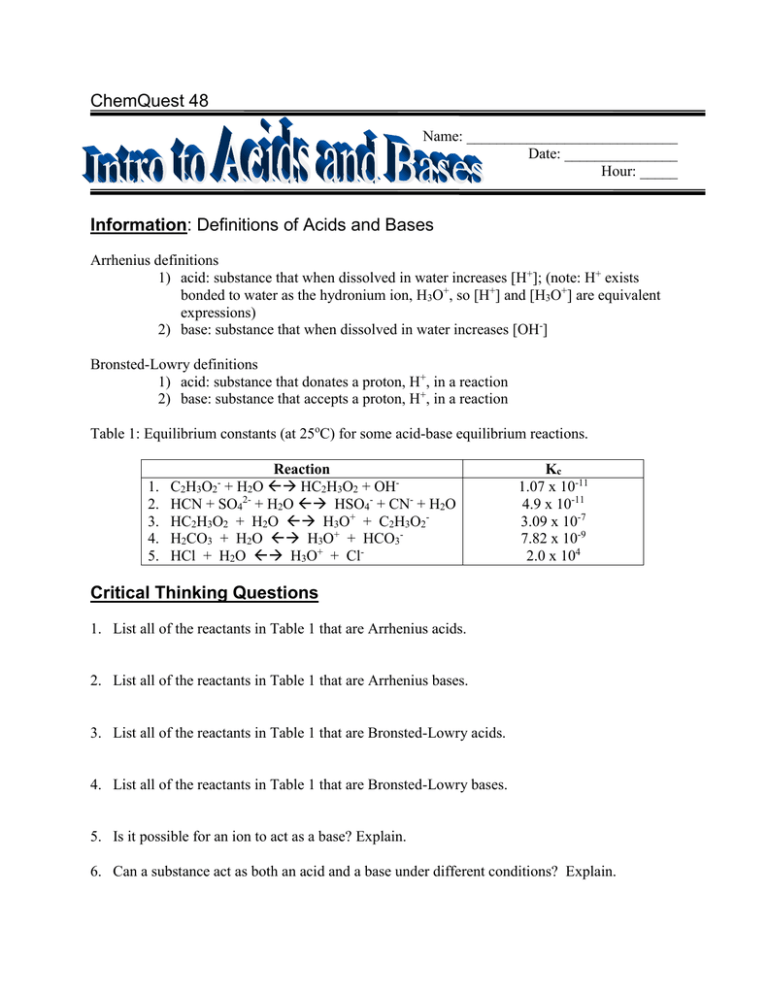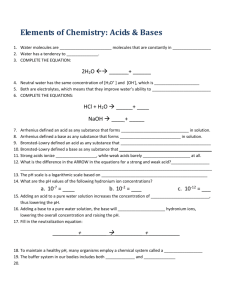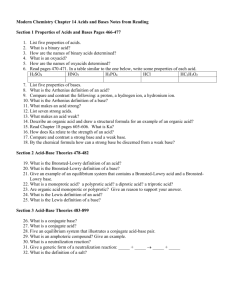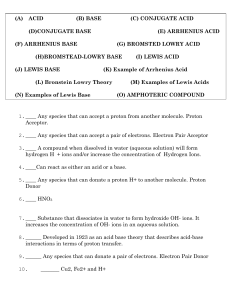Acids and Bases Worksheet: Definitions & Reactions
advertisement

ChemQuest 48 Name: ____________________________ Date: _______________ Hour: _____ Information: Definitions of Acids and Bases Arrhenius definitions 1) acid: substance that when dissolved in water increases [H+]; (note: H+ exists bonded to water as the hydronium ion, H3O+, so [H+] and [H3O+] are equivalent expressions) 2) base: substance that when dissolved in water increases [OH-] Bronsted-Lowry definitions 1) acid: substance that donates a proton, H+, in a reaction 2) base: substance that accepts a proton, H+, in a reaction Table 1: Equilibrium constants (at 25oC) for some acid-base equilibrium reactions. 1. 2. 3. 4. 5. Reaction C2H3O2- + H2O HC2H3O2 + OHHCN + SO42- + H2O HSO4- + CN- + H2O HC2H3O2 + H2O H3O+ + C2H3O2H2CO3 + H2O H3O+ + HCO3HCl + H2O H3O+ + Cl- Kc 1.07 x 10-11 4.9 x 10-11 3.09 x 10-7 7.82 x 10-9 2.0 x 104 Critical Thinking Questions 1. List all of the reactants in Table 1 that are Arrhenius acids. 2. List all of the reactants in Table 1 that are Arrhenius bases. 3. List all of the reactants in Table 1 that are Bronsted-Lowry acids. 4. List all of the reactants in Table 1 that are Bronsted-Lowry bases. 5. Is it possible for an ion to act as a base? Explain. 6. Can a substance act as both an acid and a base under different conditions? Explain. 7. Is this statement true: “All substances that are Arrhenius acids are also Bronsted-Lowry acids”? Explain. 8. If a substance is a Bronsted-Lowry acid, can we conclude that the substance is also an Arrhenius acid? Explain. 9. a) What is the strongest acid among the reactants in reactions 3-5 inTable 1? Explain. b) What is the weakest acid among the reactants in reactions 3-5 inTable 1? Explain. 10. Consider Reaction 3. a) What substance is formed (by the acid) after the acid loses a proton? b) Is this substance an acid or a base? (Hint: look at reaction 1.) 11. Drawing a conclusion from question 10, what can be said about a substance after it loses a proton? Is the substance formed acidic or basic? Information: Conjugate Acid-Base Pairs After an acid loses a proton in a reaction, the substance formed behaves like a base. Verify this by examining Reactions 3 and 1 in Table 1. Notice from reaction 3 that HC2H3O2 is an acid. After it loses a proton it becomes the acetate ion, C2H3O2-. The acetate ion is a base, as seen in reaction 1; there is a special name for this base: it is a conjugate base. So, C2H3O2- is the conjugate base of HC2H3O2. Similarly, HSO4- is the conjugate acid of SO42-. Verify this by examining Reaction 2. Critical Thinking Questions 12. Describe how a conjugate base is formed. 13. How is a conjugate acid formed? 14. For each of the acids below, write the reaction of the acid with water and circle the formula of the conjugate base in your reaction. a) H2SO4 b) HCO3c) HF 15. For each of the bases below, write the reaction of the base with water and circle the formula of the conjugate acid in your reaction. a) NH3 b) OHc) NO3-










